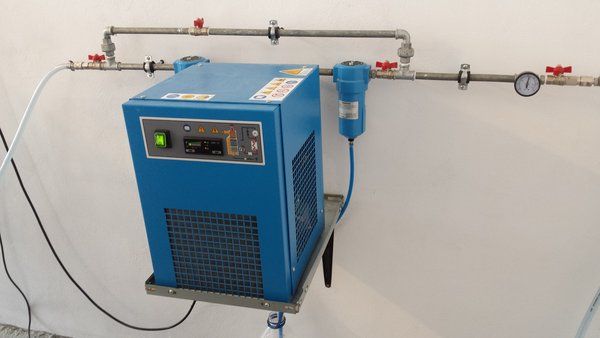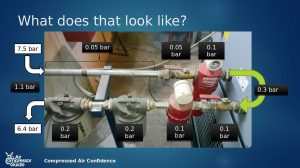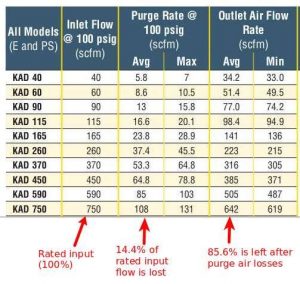
Last article talked about water in your compressed air – a problem many of us will face in their compressed air system. So, what is the best way to avoid water in your compressed air? What kind of air dryer is the best? What should you pay attention to?
How to remove water from compressed air.
The first important thing you need to know about removing water from compressed air, is that we must make a distinction between liquid water and water vapor. Liquid water Liquid water is present in your compressed air in the form of drops and aerosols. We can remove this water with a condensate trap. Condensate traps do exactly what you think they do: they trap the condensate. The condensate is then collected and discharged.  Example of electronic condensate trap mounted below an air receiver
Example of electronic condensate trap mounted below an air receiver
There are many different types of condensate traps, each with their own benefits and costs. But that’s a topic for a later article. Condensate traps can NOT remove water vapor. It’s ‘invisible’ to them. They will ONLY remove liquid water. Water vapor To remove water vapor from the air, we need a compressed air dryer. There are a lot of different types of compressed air dryers, but before we dive into that, what does it mean to remove water vapor from the air. Removing water vapor from the air means we are lowering the dewpoint (pressure dew point to be exact). We are lowering both the relative humidity and the absolute humidity. It dries the air. This means that after drying, there is still water vapor present – but it will condense into liquid at a much lower temperature (we lowered the pressure dew point). Pressure dew point The pressure dew point is the temperature at which condensate starts to form. It’s the same principle as the normal ‘dew point’, but then under pressure , in our compressed air system. What pressure dewpoint do you need? It depends on your application. For “workshop use” and other general compressed air applications – the standard pressure dewpoint is 4 °C. If you work with sensitive equipment, or in the petrochemical industry, you might need a lower dewpoint, like -30 °C or -70 °C . ## What kind of dryer do you need?
The type of compressed air dryer that you need, depends on the dewpoint that you need. And the dewpoint that you need depends on the application that you use your compressed air for. Generally speaking, 2 main types of air dryers are in use: - Refrigerated dryer
- Desiccant dryers
Refrigerated compressed air dryers Refrigerated dryers remove water vapor by simple cooling down the air to around 4 °C and then heating the air up again.  Small refrigerated compressed air dryer.
Small refrigerated compressed air dryer.
In the process, lots of water vapor will condense into liquid water. This liquid water is removed by a condensate trap. Typical pressure dew points for refrigerated dryers are around 4 °C (because of the way they work). Desiccant compressed air dryers Desiccant dryers use desiccant to remove water from the air. The desiccant absorbs the water vapor directly, as the compressed air passed through the desiccant bed. The result is dry compressed air.  Desiccant compressed air dryer - one tower is in use, while the other is being re-generated.
Desiccant compressed air dryer - one tower is in use, while the other is being re-generated.
Because the water is ‘stored’ inside the desiccant, there’s a limit to how much water vapor the desiccant can absorb. For this reason, the desiccant needs to be re-generated every so many hours. This regeneration can be done in different ways. Generally speaking, dry and/or hot air is blown over the desiccant to remove the absorbed water. Once the desiccant is regenerated, it can be used again. The desiccant can be regenerated over and over again, but there is a limit to this. Every so many thousand running hours, the desiccant needs to be replaced. ## The cost of drying compressed air
As a general rule, we should only treat the compressed air as much as we need. If we treat it too much, we create air that’s too clean for our application. Too clean? Is that a problem? Air treatment costs us money. And compressed air is very expensive. Every over-treatment of our compressed air can cost us thousands of dollars per year! In the case of water in compressed air, a lower dewpoint is always more expensive than a higher dewpoint. For general applications, a simple refrigerated dryer is more than enough. For more demanding applications, a desiccant dryer is necessary. But be careful. Desiccant dryers cost more than just the purchase price and a bit of electricity! ## Hidden costs of compressed air dryers.
As I said, drying air costs us money. But it’s not obvious right away how much money it can cost us. Pressure drop A hidden cost that every air dryer has is pressure drop. Pressure drop simple means that the pressure at the outlet of the dryer is lower than the pressure at the inlet of the dryer.  Example of pressure drops in typical compressed air treatment system. The machine on the right is a (refrigerated) compressed air dryer with a typical pressure drop of 0.3 bar. (source: Compressed Air Confidence Course)
Example of pressure drops in typical compressed air treatment system. The machine on the right is a (refrigerated) compressed air dryer with a typical pressure drop of 0.3 bar. (source: Compressed Air Confidence Course)
We have to compensate for this pressure drop by setting our air compressor setpoint higher – which costs more energy! Pressure drop occurs in both refrigerated dryers and desiccant dryers and is usually aroun 0.3 bar. Regeneration costs Desiccant dryers have a second hidden cost, and it can be quite big: regeneration. As I said before, the desiccant needs to be regenerated. Many cheaper/simpler desiccant dryers use compressed air for this. The compressed air that has just been dried is used to re-generate the desiccant. This can be around 10% of your compressed air flow, up to 20% in some cases even!  Example of purge air losses in a heatless purge desiccant air dryer - 14.4 percent
Example of purge air losses in a heatless purge desiccant air dryer - 14.4 percent
Think about it. If 10% of your compressed air is wasted, this means that you are wasting at least 10% of your electricity bill. Worst thing is, especially with the cheaper models, they regenerate even if there’s little or no compressed air use. So if you have a 37 kW air compressor that is used full time, 100% - you are wasting 3.7 kW to desiccant regeneration. Now let’s say this compressor only runs 20% of the time – it would use an average of 37 * 0.2 = 7.4 kW of electricity. That’s roughly 6.500 USD per year in energy cost. But your desiccant dryer is still happily regeneration all of the time – using 10% of its rated air flow – in other words, this dryer is using 10% of your 37 kW compressor: 3.7 kW on average. That’s 3.250 USD per year. So you use 7.4 kW for compressed air that you really use. And you use 3.7 kW for drying your compressed air. That's 1/3 of your total energy bill! It’s insane! ## Less expensive compressed air dryers
Luckily there are other options available. And I don't mean cheaper dryers - I mean dryers with lower operating costs. Better desiccant dryers don’t use compressed air for regeneration – they use ambient air (a blower) and a heater to regenerate the desiccant. Sure, it costs some electricity (especially the heater) – but it’s just a fraction of what that cheap compressed-air wasting dryer uses. This can literally cost you thousands of dollars per year. For big installations, it can go up to a tens of thousands of dollars per year – in wasted energy cost! ## Next steps
Go to your compressor room and check what kind of compressed air dryer you have: is it a refrigerated dryer, or a desiccant dryer? If it’s a desiccant dryer, what kind of regeneration process is used? - Cold compressed air (worst)
- Heated compressed air (better, but still bad)
- Heated ambient air (best)
Find the manual and figure out the % of purge air your dryer uses. Now calculate this back to energy cost per year. Shocked? Investing in a better compressed air dryer (with lower operation costs) might be a good idea! Need some more background information? Check out the previous article with more information about water in your compressed air system, relative and absoulte humidity, and dewpoints. Or, consider signing up for the Compressed Air Confidence Course – all this is explained in detail, plus you’ll get a whole better understanding of your compressed air system, and if and where you are wasting energy .

Comments
No comments yet…
Log in or create an account to make a comment...